Charles Leslie Thrasher (September 15, 1889 – December 2, 1936) was an American illustrator best known for his magazine covers for Liberty magazine and the Saturday Evening Post .
Charles Leslie Thrasher (September 15, 1889 – December 2, 1936) was an American illustrator best known for his magazine covers for Liberty magazine and the Saturday Evening Post .
Thrasher was born in Piedmont, West Virginia, on September 15, 1889, to Mason and Dorothy Thrasher. [1] As a teenager, he studied art at the Pennsylvania Academy of Fine Arts [2] and became a commercial artist at age 17. [1] After graduating, he earned a scholarship to Académie de la Grande Chaumière in Paris. [2] When he returned to the United States, he became a student of Howard Pyle. [2] [3] Thrasher's work first appeared on the cover of the Saturday Evening Post in 1912, [4] for which he eventually did twenty-three covers. [2] During the First World War, he enlisted in the 40th Engineer Battalion. He was sent to France, where he partook in camouflage work. [5] His lungs were severely damaged during a poison gas attack. [6] Returning to the United States after the war, he married his wife Janet (née Jackson) at St. Stephen's in New York City in 1920, and settled in Long Island. [1] [2] He was hired in 1924 to create a series of covers for the then-new Liberty magazine, for $1000 per week. [3] According to American Illustration's project on Leslie Thrasher, "in 1926, against the advice of fellow artist Norman Rockwell, he agreed to complete a cover a week for Liberty Magazine over a six year period." [7] His contract with Liberty was terminated in 1932 [4] because of declining circulation; Thrasher had created 360 covers for the publication. [8]
A house fire occurred at Thrasher's residence in Old Field, New York, on November 29, 1936. [5] Following cries for help from his wife, Thrasher, deaf at the time of the fire, was rescued unconscious from an upstairs bedroom by his neighbor and fellow artist, T. McFerguis Cooper. [5] He was taken by ambulance to John T. Mather Memorial Hospital, [5] where he was treated for severe smoke inhalation. [2] He developed pneumonia and died at the hospital on December 2, 1936. [5] [6] [1] The same fire destroyed much of Thrasher's work. [2]
Thrasher had one daughter, Audrey. [5]
Thrasher was a realist painter, often compared to Norman Rockwell. [4] He is usually considered inferior to Rockwell, but it is noted that he had less time to develop his art. [4] While Rockwell's backgrounds were highly detailed, Thrasher's backgrounds were simply set on white. [6] [2] Nonetheless, Thrasher is occasionally mistaken for Rockwell, in particular the piece "Tipping the Scales", which appeared on the Saturday Evening Post in October 1936. [6] [2]
Thrasher's most popular series of covers was created for Liberty and named "For the Love o' Lil." [3] Lil represented a typical (if unusually attractive) middle-class woman, and the covers represented her "life" from young womanhood to middle age. [8] "Storylines" for Lil were often suggested by readers. [4] In 1930, a movie was made featuring Thrasher's character, [4] and a radio show for the character was also produced. [8]
In addition to his magazine cover illustrations, his work was featured prominently in advertisements for Chesterfield Cigarettes, Cream of Wheat, DuPont, and the Fisk Tire Company. [6]

Norman Percevel Rockwell was an American painter and illustrator. His works have a broad popular appeal in the United States for their reflection of American culture. Rockwell is most famous for the cover illustrations of everyday life he created for The Saturday Evening Post magazine over nearly five decades. Among the best-known of Rockwell's works are the Willie Gillis series, Rosie the Riveter, The Problem We All Live With, Saying Grace, and the Four Freedoms series. He is also noted for his 64-year relationship with the Boy Scouts of America (BSA), during which he produced covers for their publication Boys' Life, calendars, and other illustrations. These works include popular images that reflect the Scout Oath and Scout Law such as The Scoutmaster, A Scout Is Reverent and A Guiding Hand, among many others.
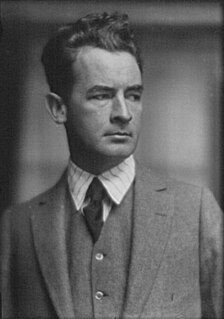
James Montgomery Flagg was an American artist, comics artist and illustrator. He worked in media ranging from fine art painting to cartooning, but is best remembered for his political posters, particularly his 1917 poster of Uncle Sam created for United States Army recruitment during World War I.

The Saturday Evening Post is an American magazine, currently published six times a year. It was issued weekly under this title from 1897 until 1963, then every two weeks until 1969. From the 1920s to the 1960s, it was one of the most widely circulated and influential magazines within the American middle class, with fiction, non-fiction, cartoons and features that reached two million homes every week. The magazine declined in readership through the 1960s, and in 1969 The Saturday Evening Post folded for two years before being revived as a quarterly publication with an emphasis on medical articles in 1971. As of the late 2000s, The Saturday Evening Post is published six times a year by the Saturday Evening Post Society, which purchased the magazine in 1982. The magazine was redesigned in 2013.

Joseph Christian Leyendecker was a German-American illustrator, considered one of the preeminent American illustrators of the early 20th century. He is best known for his poster, book and advertising illustrations, the trade character known as The Arrow Collar Man, and his numerous covers for The Saturday Evening Post. Between 1896 and 1950, he painted more than 400 magazine covers. During the Golden Age of American Illustration, for The Saturday Evening Post alone, he produced 322 covers, and many advertisement illustrations for its interior pages. No other artist, until the arrival of Norman Rockwell two decades later, was so solidly identified with one publication. He "virtually invented the whole idea of modern magazine design."

Albert Dorne was an American illustrator and entrepreneur, and was co-founder of correspondence schools for aspiring artists, photographers, and writers. Dorne was co-founder of the Code of Ethics and Fair Practices of the Profession of Commercial Art and Illustration.
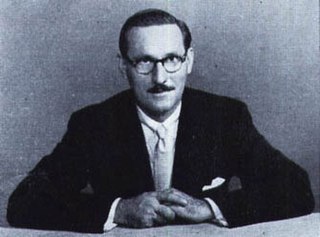
Al Parker (1906–1985) was an American artist and illustrator.
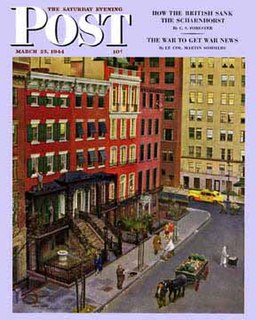
John Philip Falter was an American artist best known for his many cover paintings for The Saturday Evening Post.

Willie Gillis, Jr. is a fictional character created by Norman Rockwell for a series of World War II paintings that appeared on the covers of 11 issues of The Saturday Evening Post between 1941 and 1946. Gillis was an everyman with the rank of private whose career was tracked on the cover of the Post from induction through discharge without being depicted in battle. He and his girlfriend were modeled by two of Rockwell's acquaintances.

The Four Freedoms is a series of four 1943 oil paintings by the American artist Norman Rockwell. The paintings—Freedom of Speech, Freedom of Worship, Freedom from Want, and Freedom from Fear—are each approximately 45.75 inches (116.2 cm) × 35.5 inches (90 cm), and are now in the Norman Rockwell Museum in Stockbridge, Massachusetts. The four freedoms refer to President Franklin D. Roosevelt's January 1941 Four Freedoms State of the Union address in which he identified essential human rights that should be universally protected. The theme was incorporated into the Atlantic Charter, and became part of the charter of the United Nations. The paintings were reproduced in The Saturday Evening Post over four consecutive weeks in 1943, alongside essays by prominent thinkers of the day. They became the highlight of a touring exhibition sponsored by The Post and the U.S. Department of the Treasury. The exhibition and accompanying sales drives of war bonds raised over $132 million.

Freedom from Want, also known as The Thanksgiving Picture or I'll Be Home for Christmas, is the third of the Four Freedoms series of four oil paintings by American artist Norman Rockwell. The works were inspired by United States President Franklin D. Roosevelt's 1941 State of the Union Address, known as Four Freedoms.
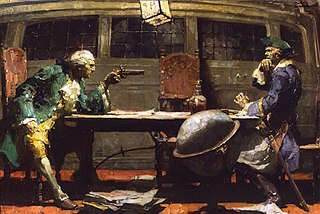
Mead Schaeffer was an American illustrator active from the early to middle twentieth century.
Maxwell Coburn Whitmore was an American painter and magazine illustrator known for his Saturday Evening Post covers, and a commercial artist whose work included advertisements for Gallo Wine and other national brands. He additionally became known as a race-car designer.

Earl Mayan was an American illustrator whose early career spanned the era of pulp magazines to the post World War II years alongside Norman Rockwell at The Saturday Evening Post. From 1954 to 1961, he painted ten Saturday Evening Post covers and illustrated many of the stories that appeared as inside the magazine.
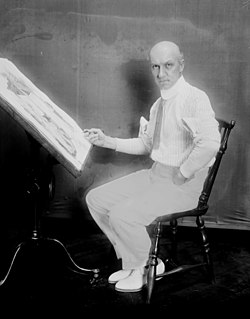
Orson Byron Lowell (1871–1956) was an American artist and illustrator of covers and interiors for magazines.
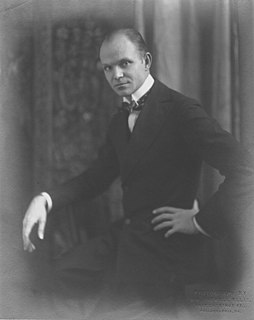
Adolph Treidler (1886–1981) was an American artist known for his illustrations, posters, commercial art, and wartime propaganda posters.

Remington Schuyler (1884–1955) was an American painter, illustrator and writer during the early to mid twentieth century. He was born in Buffalo, New York and was named after Frederic Remington, a distant cousin of his mother and an accomplished artist from the period.
The New Rochelle artist colony was a community of artists, actors, musicians, playwrights and writers who settled in the city of New Rochelle, New York, during the early twentieth century. By the 1920s, New Rochelle had more artists per capita than almost any city in the United States, and newspaper headlines were referring to the community as "Greenwich Village without the Greenwich."

John La Gatta, also spelled LaGatta, was an advertising illustrator active during the first half of the 20th century.
John Carlton Atherton was an American painter and magazine illustrator, writer and designer. His works form part of numerous collections, including the Museum of Modern Art, Whitney Museum of American Art and the Smithsonian American Art Museum.

Emmett St. Clair Watson, Jr. was an American illustrator whose works appeared in popular magazines such as The Saturday Evening Post, Judge, Collier's, and Life, and also in pulp magazines such as Argosy, Railroad Stories, Detective Fiction Weekly,